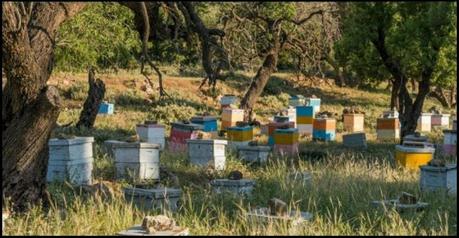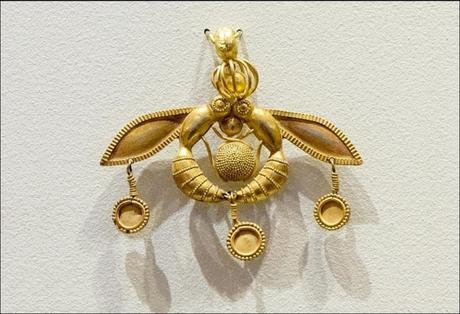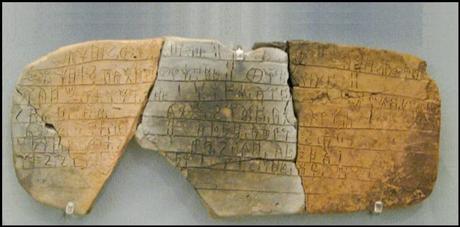Apiculture (bee-keeping) has a long history in the Aegean. The ancients believed that bees were messengers from the Gods, intermediaries between heaven and earth, and that honey was a source of wisdom and poetry. The Minoans had a bee goddess, Potnia, and her priestesses were called Melissa (which means bee, from meli the word for honey). In later Greek mythology, Aristaeus was the god of bee-keeping.By 600 BC bee-keeping was a fully developed and legally regulated concern in Greece and honey was valued not only as a food, the first natural sweetener and good source of energy, but also for its medicinal properties (both taken internally and used as a salve) and - in the form of beeswax - as a cosmetic in beauty masks. The great Koan doctor Hippocrates regarded honey as a panacea and the philosopher Aristotle wrote his first book on the art of keeping the little fellows.There is even a Greek bee, apis mellifera cecropia , a sub-species of honey bee, favoured for its extreme gentleness and lack of a tendency to swarm. It thrives in the southern Mediterranean climate, for it likes the warmth and low humidity, and is not suited to the cooler climate of northern Europe.Greece, in fact, has more beehives per acre than any other country in Europe. The wide biodiversity of its flora combined with powerful summer sun means its varieties of honey are dense, rich and among the finest.

a colony of colourful Greek hives
There are six main types: Thyme honey (the most highly thought of) produced from the thyme flowers of Crete and Kythera in spring; Blossom honey from wild flowers and orange groves in Halkidiki; Chestnut honey (the rarest) from Epirus, possessed of a faint, pleasant bitterness; Pine honey, high in antioxidants and minerals, accounts for 65% of all Greece produces; Heather honey, produced in early autumn when the heather blossom, is dark, thick and crystalline; Fir honey, from Vytina in the Peloponnese, is the only certified PDO honey.Because it was Greek week at Lidl supermarket last week, I have been enjoying authentic Greek yoghurt with dried figs and Halkidiki honey for breakfast recently.
My favourite, though, is the thyme honey from dusty Crete, which I discovered when visiting the island nearly half a century ago. They do say that first impressions are lasting ones. It is very possible that Minoan Crete, nearly 4,000 years in the past, was the birthplace of apiculture, of bee worship (referenced above) and of the high regard for honey as a valuable and health-giving commodity. The beautiful Malia pendant, discovered at Malia in Crete in 1930, is graphic testament to this regard. It dates from approximately 1800 BC, is worked in gold and shows two symmetrical bees. It's the most stunning piece of Minoan jewelry and if you ever get the chance to to go Heraklion Archaeological Museum, do seek it out.

famous bee pendant
Today's poem is partly in memory of that first visit to Crete in 1974. We pitched tent and stayed for a few days on Amnissos beach to the east of Heraklion. It was deserted. This was pre-hotels, villas, tourist package holidays, more the tail-end of the hippy trail. The area was unspoiled, unbuilt-up, probably looking much like it had for the last several hundred years. It was also the summer of the Cyprus war (the last major military engagement between Greeks and Turks), so many had been deterred from visiting the region.It was quite symbolic to me, having read Homer, to know that we were camping in a place where Odysseus had made landfall: "He had been driven to Crete by a gale which had blown him off his course at Cape Malea when bound for Troy. He put in at Amnissos, where the cave of Eileithyie is - a difficult harbor to make - only just escaping from the storm." (The Odyssey, XIX, lines 186 following.) Amnissos was the harbor for the bronze-age Minoan palace-town of Knossos circa 1380 BC. The sea-level is 3 metres higher now than it was in the bronze age, but the walls of submerged houses are still visible from the current shore. It was also here during excavations in 1932 that fragmented clay tablets were uncovered bearing a script that came to be known as Linear B.

Linear B clay tabled reconstructed
For a long time, archaeologists and classicists argued about the nature and origins of the script, many suggesting it was more akin to Babylonian or Egyptian hieroglyphs than anything else and that the artefacts had probably been brought to Crete (and mainland Greece) by traders. The truth, when the code was finally cracked by Michael Ventris in the 1950s, was that Linear B is actually a written form of early Greek, though obviously the symbols differ from the script that became dominant in the Aegean with the rise to prominence of the Mycenaeans. It is now known that writing in Linear B on clay tablets was a common practice in Minoan times to record inventories, trading transactions, treaties and official documents - but it is in the nature of clay to soften and crumble, so that 99.99% of these artefacts had only a limited life and were often broken down into soft clay to be reused. The 0.001% that we have today only survived because they were accidentally (and providentially) baked to hardness and thus durability in the fires that burned the great Minoan palaces to the ground in an act of war.Here then (finally, you say), flowing from the Hellenic chamber of the Imaginarium, my latest...
Amnissos 1974Broken Knossos somewhere to our backs,here on wide Amnissos beach whose sandstill radiates as twilight steals the day, wesit and conjure visions of longships hulledalong its shore, tents pitched just like ours and fires roasting fish and flesh. Phantomsroar in war formation, shattering the mood,an age-old enmity renewed in Eastern skieswith Cyprus the prize; once quiet descendsagain we contemplate past times and place,a gentle murmur of lapis waves contrastingwith such echoing ire as torched a Minoan palace, the trick of destruction which savedin perpetuity clay tablets bearing baked-inwitness shaped in ancient script to ordinary lives. Those testimonies, rendered shards infurther acts of desecration, lay buried in theCretan sand we sit on as history ran full tiltdown three millennia until, disinterred anddeciphered in our very lifetime, they spokethrough strife and smoke against all odds -my favourite: "one jar of honey to the Gods".
Thanks for reading. Keep eating honey, S ;-)
